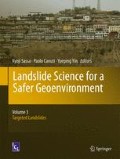Abstract
Recurrence of rain-induced landslides is controlled by the repetition of rain events. Therefore, rainfall induced landslide hazard analysis is more complicated than a conventional rainfall frequency analysis, and requires multi-stage procedures. It requires a susceptibility analysis to divide a region into successive classes at the first stage. Then, the relationship between the probability of landslide failure and rainfall intensity and/or total rainfall of an event for each susceptibility classes may be constructed, and further fit a probability of failure surface using the susceptibility value, rainfall intensity and/or total rainfall as independent variables. Then, frequency analysis for rainfall parameters at different return periods is performed. Finally, an analysis of the spatial probability of landslide failure under a certain return-period rainfall is drawn. This study selects data for Typhoon Haitang induced landslides in the Kaopin river basin as the training data set to perform a susceptibility analysis and a probability of failure surface analysis. A rainfall frequency analysis is also conducted to map different return-period rainfall intensity and 3-day rainfalls. Finally, a rainfall landslide hazard map is provided.
Access this chapter
Tax calculation will be finalised at checkout
Purchases are for personal use only
References
Brenning A (2005) Spatial prediction models for landslide hazards: review, comparison and evaluation. Nat Hazard Earth Syst Sci 5(6):853–862
Carrara A (1983) Multivariate models for landslide hazard evaluation. Math Geol 15(3):403–427
Chow VT (1953) Frequency analysis of hydrologic data with special application to rainfall intensities. University of Illinois Engineering Experiment Station, Bulletin Series, 414, 81p
Claessens L, Schoorl JM, Veldkamp A (2007) Modelling the location of shallow landslides and their effects on landscape dynamics in large watersheds: an application for Northern New Zealand. Geomorphology 87:16–27
Fowler HJ, Kilsby CG (2003) A regional frequency analysis of United Kingdom extreme rainfall from 1961 to 2000. Int J Climatol 23(11):1313–1334
Guzzetti F, Carrara A, Cardinali M, Reichenbach P (1999) Landslide hazard evaluation: a review of current techniques and their application in a multi-scale study, Central Italy. Geomorphology 31:181–216
Guzzetti F, Reichenbach P, Cardinali M, Galli M, Ardizzone F (2005) Probabilistic landslide hazard assessment at the basin scale. Geomorphology 72:272–299
Iverson RM (2000) Landslide triggering by rain infiltration. Water Resour Res 36:1897–1910
Lee CT, Fei LY (2011) Landslide hazard analysis and mapping in a wide area. Sino-Geotechnics 129:53–62 (in Chinese with English abstract)
Lee CT, Huang CC, Lee JF, Pan KL, Lin ML, Liao CW, Lin PS, Lin YS, Chang CW (2004) Landslide susceptibility analyses based on three different triggering events and result comparison. In: Proceeding of international symposium on landslide and debris flow hazard assessment, Taipei, pp 6-1~6-18
Lee CT, Huang CC, Lee JF, Pan KL, Lin ML, Dong JJ (2008a) Statistical approach to earthquake-induced landslide susceptibility. Eng Geol 100:43–58
Lee CT, Huang CC, Lee JF, Pan KL, Lin ML, Dong JJ (2008b) Statistical approach to storm event-induced landslide susceptibility. Nat Hazard Earth Syst Sci 8:941–960
Lee CT, Chang CW, Lin SH (2012) Landslide hazard analysis and mapping in a wide region. EGU General Assembly Conference Abstracts 14
Montgomery DR, Dietrich WE (1994) A physical-based model for the topographic control on shallow landsliding. Water Resour Res 30(4):1153–1171
Van Westen CJ, van Asch TWJ, Soeters R (2006) Landslide hazard and risk zonation - why is it still so difficult? Bull Eng Geol Environ 65:167–184
Author information
Authors and Affiliations
Corresponding author
Editor information
Editors and Affiliations
Rights and permissions
Copyright information
© 2014 Springer International Publishing Switzerland
About this paper
Cite this paper
Lee, CT. (2014).
 Multi-stage Statistical Landslide Hazard Analysis: Rain-Induced Landslides.
In: Sassa, K., Canuti, P., Yin, Y. (eds) Landslide Science for a Safer Geoenvironment. Springer, Cham. https://doi.org/10.1007/978-3-319-04996-0_45
Multi-stage Statistical Landslide Hazard Analysis: Rain-Induced Landslides.
In: Sassa, K., Canuti, P., Yin, Y. (eds) Landslide Science for a Safer Geoenvironment. Springer, Cham. https://doi.org/10.1007/978-3-319-04996-0_45
Download citation
DOI: https://doi.org/10.1007/978-3-319-04996-0_45
Published:
Publisher Name: Springer, Cham
Print ISBN: 978-3-319-04995-3
Online ISBN: 978-3-319-04996-0
eBook Packages: Earth and Environmental ScienceEarth and Environmental Science (R0)

